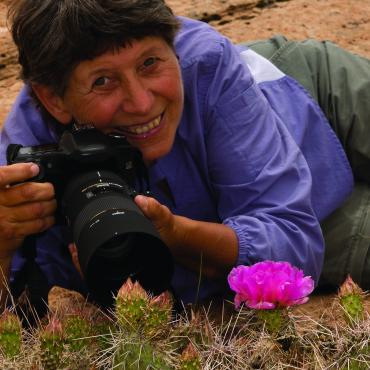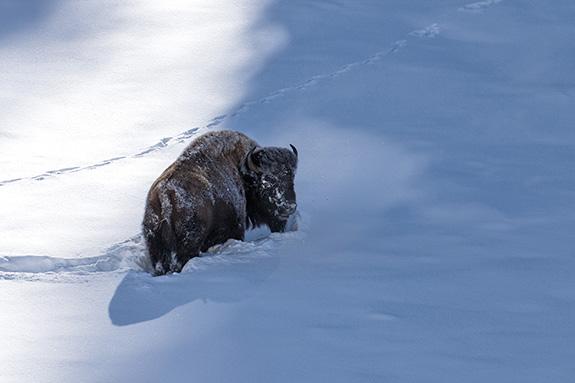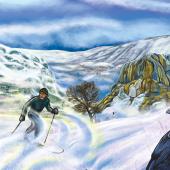Surviving the Extremes
How animals respond to the cold.
Intent, staring eyes; ears and tail erect; feet gather under thick gray fur: the predator is ready to pounce. Then, with a slight quiver, feet and legs shift as muscled legs tighten. Timing is everything as the coyote launches himself skyward with three feet of air between his body and the snow, the dive and kill fine-tuned to perfection. At first, the coyote is vertical, and then arched, before his body lengthens into a torpedo-shaped dive. Head first, the coyote’s head disappears, leaving two-thirds of his body exposed, with an animated, wagging tail flailing skyward. He emerges victoriously with a mouthful of lunch. The sleuthing predator has had immediate success.
Throughout all seasons, with astounding hearing and exquisite skill, foxes and coyotes leap and pounce, as their prey scurry below the surface. You can’t help but applaud the theatrics and root for the predator. I once clocked a coyote for an hour where it had a success rate of a mouse every 20 minutes. As I drove away, the predator continued to hunt. I wondered how many voles it needed to fill its tummy.

For animals both wild and domestic, surviving below-freezing temperatures in deep snow is a full-time job; conserving energy in these conditions is a constant consideration. The domino effect takes place within the risky throes of a Yellowstone winter, with bison often leading the way by forming paths in snow that are over five feet deep. With a specially-equipped vertebra supporting muscles within its hump, the bison’s huge head sweeps back and forth as it ploughs through and bulldozes the snow. The nutritional value of the cardboard-like grasses is low, but it’s enough to subsist on for over three months before spring grasses reemerge.

Coyotes, foxes, wolves, deer, and elk utilize these paths all winter long, the energy saved making their survival more likely. Symbiotic relationships help with co-existence in other ways as well, and opportunists such as the magpies and ravens are forever on the lookout for a tasty meal when predators leave carcasses behind. One such relationship exists between bison and magpies, which feed on insects settled within the bovine fur. These birds also gather fur for nest-building, pecking near the eyes or on the furry flanks of the bison.

Magpies also play a crucial role in garbage-collecting. The tussle is on when an eagle lands to claim fresh meat while the magpies jump and squawk near the outlying scraps. Magpies and ravens are full of skilled ploys while distracting the larger bird. A co-conspiracy forms when the nuisance bird flies and pecks at the eagle’s tail. While distracted, a second magpie jumps on the carcass and swiftly grabs a scrap of carrion.

Another wary survivor is the elk. Conifer needles don’t sound too appetizing to us, but, if grasses aren’t available, then the needles become a “delicacy,” with many being high in vitamin C. Elk are often seen nibbling and reaching high with teeth bared, grasping at the edible needles. Where bison have left their plowed channels, the few remaining blades of grass are snatched up by elk who are both browsers and grazers.
On the opposite end of the survival spectrum is the well-fed rancher’s stock. Feed is dropped for them in close quarters or further out in pastures. Many domestic animals have the life of luxury when the hay is spread out on the ground or within feed bins by a weathered rancher in tune with Mother Nature’s elements. Everyone adjusts and adapts to the change of seasons, when the bite of cold creates hoar-frosted fur and whiskers and human fingers and toes are numbed in the frigid zone.
Before the onset of winter, animals grow their velvet-like fur to a thickness that can easily buffer the deep freeze from their bodies. Of course, keeping themselves well-fed is a requirement for insulating fat and warmer bodies. To shield against the wind, horses position their backsides to the blustery elements. Shielded by their butts and backs in inclement weather with tails freely blowing, they’re content to munch within their white oblivion. Whenever there is a herd, a hierarchy is established. Displays and disputes are common occurrences. Sometimes, there are flattened ears with teeth bared while others turn their flanks and lash out with lightning kicks. Once the dispute is settled and everyone knows who is top dog, the hay rapidly diminishes. The domestic life has fencing and trees which are preserved and encased in a frozen environ. They fade into a white impressionistic background. Here, survival tactics are less stressful, though life can still be painful within sub-zero elements.

During early spring, when it’s still snowy and blustery, snowflakes drift and flutter like butterflies caught in the wrong season. The scenic environment becomes ethereal and magical. March snow-squalls blow in quickly. Robins flutter among the trees, grabbing the early spring berries, while high winds and snow force fleeing elk to the lee side of a hill. Once the wind subsides and snow blows out, a tranquil scene follows.
Even though snow depths are less prevalent during the early spring season and grasses appear, the sudden change in weather can overpower the already weakened winterized bodies of much wildlife. Thus, surviving the extremes takes the animals through a series of extreme weather changes where healthy endurance is a must.














